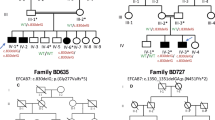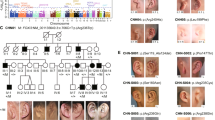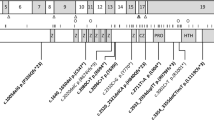Abstract
Pallister-Hall syndrome (PHS, M146510) was first described in 1980 in six newborns. It is a pleiotropic disorder of human development that comprises hypothalamic hamartoma, central polydactyly, and other malformations1,2. This disorder is inherited as an autosomal dominant trait and has been mapped to 7p13 (S. Kang et al. Autosomal dominant Pallister-Hall syndrome maps to 7p13. Am. J. Hum. Genet. 59, A81 (1996)). co-localizing the PHS locus and the GLI3 zinc finger transcription factor gene3. Large deletions or translocations resulting in haploinsufficiency of the GLI3 gene have been associated with Greig cephalopolysyndactyly syndrome (GCPS; M175700)4–6 although no mutations have been identified in GCPS patients with normal karyotypes. Both PHS and GCPS have polysyndactyly, abnormal craniofacial features and are inherited in an autosomal dominant pattern, but they are clinically distinct7,8. The polydactyly of GCPS is commonly preaxial and that of PHS is typically central or postaxial. No reported cases of GCPS have hypothalamic hamartoma and PHS does not cause hypertelorism or broadening of the nasal root or forehead. The co-localization of the loci for PHS and GCPS led us to investigate GLI3 as a candidate gene for PHS. Herein we report two PHS families with frameshift mutations in GLI3 that are 3′ of the zinc finger-encoding domains, including one family with a de novo mutation. These data implicate mutations in GLI3 as the cause of autosomal dominant PHS, and suggest that frameshift mutations of the GLI3 transcription factor gene can alter the development of multiple organ systems in vertebrates.
This is a preview of subscription content, access via your institution
Access options
Subscribe to this journal
Receive 12 print issues and online access
$209.00 per year
only $17.42 per issue
Buy this article
- Purchase on Springer Link
- Instant access to full article PDF
Prices may be subject to local taxes which are calculated during checkout
Similar content being viewed by others
References
Hall, J.G. et al. Congenital hypothalamic hamartoblastoma, hypopituitarism, imperforate anus, and postaxial polydactyly-A new syndrome? Part I: Clinical, causal, and pathogenetic considerations. Am. J. Med. Genet. 7, 47–74 (1980).
Clarren, S.K. Alvord, E.C. & Hall, J.G. Congenital hypothalamic hamartoblastoma, hypopituitarism, imperforate anus, and postaxial polydactyly-A new syndrome? Part II: Neuropathological considerations. Am. J. Med. Genet. 7, 75–83 (1980).
Ruppert, J.M. Vogelstein, B. Arheden, K. & Kinzler, K.W. GLI3 encodes a 190-kilodalton protein with multiple regions of GLI similarity. Mol. Cell. Biol. 10, 5408–5415 (1990).
Pettigrew, A.L. Greenberg, F. Caskey, C.T. & Ledbetter,, D.H. Greig syndrome associated with an interstitial deletion of 7p: confirmation of the localization of Greig syndrome to 7p13. Hum. Genet. 87, 452–456 (1991).
Vortkamp, A. Gessler, M. & Grzeschik, K.-H. GLI3 zinc finger gene interrupted by translocations in Greig syndrome families. Nature 352, 539–540 (1991).
Brueton, L. Hudson, S.M. Winter, R.M. & Williamson, R. Chromosomal localisation of a developmental gene in man: Direct DNA analysis demonstrates that Greig cephalopolysyndactyly maps to 7p13. Am. J. Med. Genet 31, 799–804 (1988).
Duncan, P.A. Klein, R.M. Wilmot, P.L. & Shapiro, L.R. Greig cephalopolysyndactyly syndrome. Am. J. Dis. Child. 133, 818–821 (1979).
Biesecker, L.G. & Graham, J.M. Jr. Syndrome of the month: Pallister-Hall syndrome. J. Med. Genet. 33, 585–589 (1996).
Biesecker, L.G. et al. Exclusion of candidate loci and cholesterol biosynthetic abnormalities in familial Pallister-Hall syndrome. J. Med. Genet. 33, 947–951 (1996).
Grebe, T.A. & Clericuzio, C. Autosomal dominant inheritance of a hypothalamic hamartoma associated with polysyndactyly: Heterogeneity or variable expressivity? Am. J. Med. Genet. 66, 129–137 (1996).
Topf, K.F. Kletter, G.B. Kelch, R.P. Brunberg, J.A. & Biesecker, L.G. Autosomal dominant transmission of the Pallister-Hall syndrome. J. Pediatr. 123, 943–946 (1993).
Verloes, A. David, A. Ngô, L. & Bottani, A. Stringent delineation of Pallister-Hall syndrome in two long-surviving patients: importance of radiologic anomalies of the hands. J. Med. Genet. 32, 605–611 (1995).
Graham, J.M. Jr Harris, M. Frank, J.E. Little, G.A. & Klein, R.Z. Congenital hypothalamic hamartoblastoma syndrome: Natural history and genetic implications, in Endocrine Genetics and Genetics of Growth (eds. Papadatos, C.J. & Bartsocas, C.S.) 163–174 (Alan R Liss, New York, 1985).
Hui, C.-C. & Joyner, A. A mouse model of Greig cephalopolysyndactyly syndrome: the extra-toesJ mutation contains an intragenic deletion of the Gli3 gene. Nature Genet. 3, 241–246 (1993).
Brueton, L.A. Chotai, K.A. van Herwerden, L. Schinzel, A. & Winter, R.M. The acrocallosal syndrome and Greig syndrome are not allelic disorders. J. Med. Genet 29, 635–637 (1992).
Biesecker, L.G. et al. Report from the workshop on Pallister-Hall syndrome and related disorders. Am. J. Med. Genet. 65, 76–81 (1996).
Detection of mutations by single stranded conformation polymorphism analysis, in Current Protocols in Human Genetics (eds. Dracopoli, N.C. et al.) 7.4.1–7.4.6 (John Wiley and sons. New York, 1994).
Amplification of sequences from affected individuals, in Current Protocols in Human Genetics (eds. Dracopoli, N.C. et al.) 7.1.1–7.1.4 (John Wiley and Sons, New York, 1994).
Cohn, D.H. Starman, B.J. Blumberg, B. & Byers, P.H. Recurrence of lethal osteogenesis imperfecta due to parental mosaicism for a dominant mutation in a human type I collagen gene (COLIAI). Am. J. Hum. Genet. 46, 591–601 (1990).
Author information
Authors and Affiliations
Corresponding author
Rights and permissions
About this article
Cite this article
Kang, S., Graham, J., Olney, A. et al. GLI3 frameshift mutations cause autosomal dominant Pallister-Hall syndrome. Nat Genet 15, 266–268 (1997). https://doi.org/10.1038/ng0397-266
Received:
Accepted:
Issue Date:
DOI: https://doi.org/10.1038/ng0397-266
This article is cited by
-
Prenatal diagnosis of Pallister-Hall syndrome: ultrasound, magnetic resonance imaging, and three-dimensional reconstructions of phenotypical findings
Journal of Ultrasound (2023)
-
Bi-allelic SMO variants in hypothalamic hamartoma: a recessive cause of Pallister-Hall syndrome
European Journal of Human Genetics (2022)
-
Signaling network regulating osteogenesis in mesenchymal stem cells
Journal of Cell Communication and Signaling (2022)
-
Hypothalamic hamartoma associated with polymicrogyria and periventricular nodular heterotopia in children: report of three cases and discussion of the origin of the seizures
Child's Nervous System (2022)
-
GLI3: a mediator of genetic diseases, development and cancer
Cell Communication and Signaling (2020)



